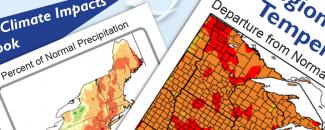
NOAA and its partners have released the latest Regional Climate Impacts and Outlooks, which recap winter conditions and provide insight into what to expect this spring.
Winter Temperature Recap
Above-average winter temperatures were observed across much of the eastern half of the U.S. and also across parts of the Deep South. Florida, Georgia, Alabama and Tennessee had winter temperatures that ranked among their 10 warmest. Despite a very cold two-week stretch across much of the Midwest in late January, no state was record cold.
Spring Temperature Outlook
Through April, May, and June, the odds favor below-average temperatures throughout much of the Great Plains while above-average temperatures are favored in the Pacific Northwest, along the Atlantic and Gulf Coast States, and across Alaska.
Winter Precipitation Recap
Above-average precipitation was observed across all but five of the Lower-48 states. Tennessee ranked wettest, while Wisconsin ranked second wettest. Nineteen states from the Great Plains to the East Coast and south to the Gulf of Mexico ranked in the top 10 wettest on record for winter. No state ranked below-average for winter precipitation. With 46.1 inches of snow, Omaha, Nebraska, set a new record for its snowiest winter. The previous record was 44.3 inches and occurred in the winter of 2003–04.
Spring Precipitation Outlook
The spring outlook favors above-average precipitation from the Rocky Mountains to the Gulf Coast and into the mid-Atlantic states as well as across Alaska. Below-average precipitation is favored to occur in the Pacific Northwest.
Impacts and Outlooks for Your Region
Get more details for your region in the March 2019 climate impacts and outlooks summaries:
- Alaska and Northwestern Canada Region
- Northeast Region
- Great Lakes Region
- Gulf of Maine Region
- Midwest Region
- Missouri River Basin Region
- Pacific Region
- Southeast Region
- Southern Region
- Western Region
Creating These Quarterly Summaries
NOAA’s Regional Climate Services lead the production of these quarterly summaries of climate impacts and outlooks for various regions of the United States as well as parts of Canada along the border. This effort, which began in 2012, now includes as many as 10 unique regional products, all produced collaboratively with partner organizations.
You can access all of the Climate Impacts and Outlooks summaries as well as additional reports and assessments through the U.S. Drought Portal Reports web page at Drought.gov.



